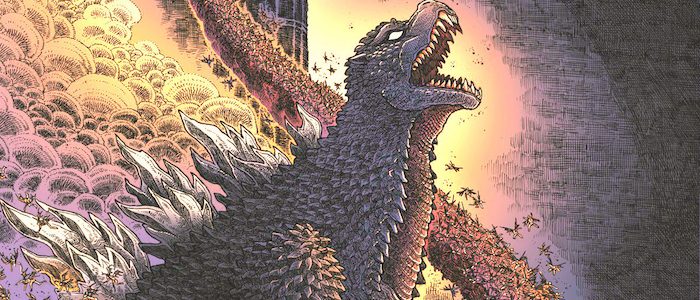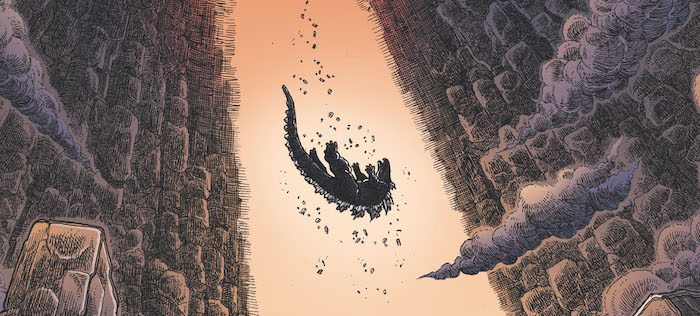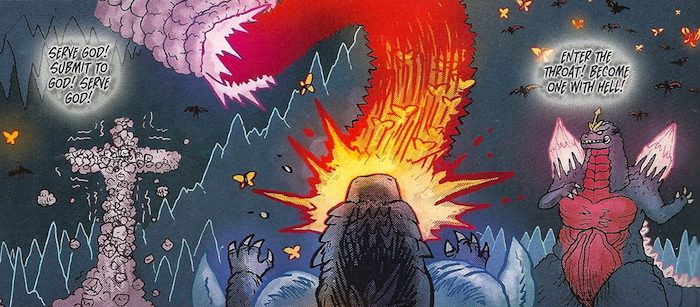
There are plenty of long-running series out there, but few can match the quantity Godzilla boasts. With over 30 features to date (not counting anime projects or the upcoming Godzilla vs. Kong), the big lizard sits in rarified territory with the likes of James Bond and Zatoichi. He’s been around a while. And given the “vs” nature of so many of those sequels, it’s safe to say we’ve seen the guy get in a lot of fights. It’s also safe to say he survives most of them.
So the idea of sending him to Hell holds a lot of novelty value. The concept implicitly promises not only a look at what would happen were Godzilla to somehow die, but a tale told on a cosmic scale, free from the regular old building-stomping and lame human characters we’ve already seen a million times (okay, over 30 times).
One imagines the creators of Godzilla in Hell coming up with the idea in the first place, laughing at the silliness of it, slowly quieting down as their individual imaginations started firing off half-ideas, eyeballing each other in a cowardly showdown to not be first to say “hey, maybe we should really do it,” sighing in relief when everyone discovers they were secretly in complete agreement, laughing again, celebrating with a bit more blow, and promising each other to start work on it first thing in the morning.
And that was probably the most fun anyone had making this five-issue comic, because the beauty of Godzilla in Hell exists only before you read it. As things start getting nailed down, its inherent possibilities shrink and reality hardens: this is a character who cannot speak, doesn’t emote, has limited mobility, and can’t really be hurt. Whatever story you get out of him is going to be limited, even in Hell.
While my hypothetical of the project’s origin is completely made up, it does help to explain the comic, which eschews all but the thinnest narrative across five issues all written and drawn by different people (though each is edited by Bobby Curnow and benefited from the creative consultation of Chris Mowry). Instead of a graphic novel telling one well-planned and organized story, Godzilla’s journey through Hell is more of an impressionistic fantasy featuring a whole lot of monsters and monster asses getting kicked.

The book is good and silly right off the bat as issue one opens with Godzilla simply falling into Hell and seeing a gigantic plaque proclaiming Dante’s “Abandon All Hope, Ye Who Enter Here.” Maybe Godzilla can read. Maybe he just hates things that are bigger than him. Either way, he immediately destroys it and walks away from the wreckage, taking his first of many (many many) steps through the afterlife. Even while dead and confused, his immediate instinct is to break things.
Godzilla confronts many foes in Hell. Demons, Angels, a giant mountain that might be God. But he tussles with many demons in familiar kaiju form as well. Obviously Rodan and Ghidorah show up, but more obscure, fan-favorite baddies appear as well like Destoroyah, Anguirus and SpaceGodzilla. In fact, we learn in Issue Three that a battle with SpaceGodzilla is what killed Godzilla in the first place (well, they create a blast that blows up the entire planet, so if you were ever wondering what it would take to kill Godzilla once and for all, the news isn’t optimistic). Each issue is radically different from the last, but almost all involve a battle of some sort.
Because each issue is so different, they each feature different highlights. Issue Two for instance, has the benefit of narration, written in dramatic script like heavy metal lyrics. The idea of a silent comic is cool, but a little help goes a long way. Issue Five might be the busiest, as Godzilla allows himself to be eaten by a bunch of winged Hellbeasts who all become little Godzillas and help him reform strong enough to murder God or Satan or whoever is keeping him from resurrecting himself—which he does, ending the book emerging from the ocean, implying Godzilla not only brought himself back to life but the entire planet along with him. Is there a panel where we humans thank him for restoring our puny lives? No, of course there isn’t.

Due to the book’s impressionistic simplicity, some fraction of its draw goes unanswered. Hell doesn’t make a ton of sense as a setting, which limits how exciting it is overall. Godzilla’s feelings about the place go unexplored. The battles themselves are short and almost enter the realm of perfunctory.
Nevertheless, it’s fun to see Godzilla in such a different situation after watching him stomp so many cities. And if anyone is looking for great images to airbrush onto their panel van, you’ll find an infinite amount of inspiration here.
The post What Chance Does Kong Have? Not Even Hell Can Kill Godzilla appeared first on /Film.
0 Comments